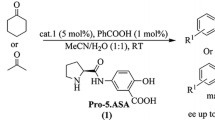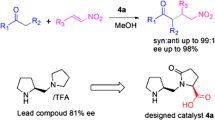Abstract
During the course of my research in asymmetric organocatalysis, inversion of enantioselectivity was observed in the asymmetric aldol reactions of acetone with different aldehydes catalyzed by amphiphilic proline derivatives in aqueous media by varying only achiral components. It was not possible to explain the explored dual stereocontrol with the existing models, therefore I proposed a new mechanism for asymmetric aldol reactions catalyzed by l-amino acid derivatives in aqueous media and explained the explored phenomenon of inversion of enantioselectivity with different structures of micelle-stabilized transition state described as a metal-free version of the Zimmerman-Traxler model with explicit participation of a water molecule. Contrary to the existing models, according to the proposed mechanism, the formation of new bonds proceeds directly in the transition state stabilized by a water molecule, without the additional step of product iminium ion hydrolysis. The proposed mechanism has universal character, it is consistent with experimental results and general theoretical conceptions, and it is applicable to all enamine-based asymmetric organocatalytic reactions carried out not only in aqueous, but in organic media as well, because the initial step of catalytic cycle, which involves the formation of an enamine from the carbonyl compound and proline (derivative), liberates one water molecule.
Similar content being viewed by others
Avoid common mistakes on your manuscript.
Introduction
After the breakthrough in enantioselective organic synthesis, when the first intermolecular asymmetric aldol reaction catalyzed by a small organic molecule (organocatalyst) was published by List and co-workers in 2000 [1], major research efforts have been focused on this system to study the effect of reaction parameters and to clarify the mechanism of the reaction. The stereoselectivity of the reaction was explained by List and co-workers with enamine mechanism, where the transition state was initially described as a metal-free version of the Zimmerman-Traxler model. Carboxylic H-atom of proline plays the key role in this structure by interaction via hydrogen bonding with N-atom of pyrrolidine ring and with O-atom of aldehyde carbonyl group, thus stabilizing the six-membered ring of transition state and explaining the stereochemical outcome of the reaction. Later, recognizing that the applied structure is energetically unfavorable (carboxylic hydrogen cannot effectively bind two proton acceptors), List in his review [2] “sacrificed” the OH··N hydrogen bond and proposed Houk’s transition state (List-Houk model) instead of metal-free version of the Zimmerman-Traxler model. Despite the fact that List-Houk model ignores the role of so important electron donor as N-atom of pyrrolidine ring (active center of catalyst) in the transition state stabilization and it can only be considered as a pseudo six-membered ring in the explanation of stereoselectivity, this model up to now is the accepted transition state in the enamine-based asymmetric organocatalysis by scientific community.
Results and discussions
During the research work in the field of asymmetric organocatalysis, my aim was to realize dual stereocontrol in the asymmetric aldol reactions catalyzed by l-amino acid derivatives in aqueous media by varying only achiral components.
Asymmetric aldol reactions between acetone and different aldehydes catalyzed by hydroxyproline derivatives in organic and aqueous media were carried out in batch reactor. In the reactions, commercially available catalysts (l-proline, l-hydroxyproline, O-benzyl-Hyp-HCl) and catalysts newly synthesized by methods known from the literature (O-(4-tert-butylbenzoyl)-Hyp, O-benzoyl-Hyp, O-caproyl-Hyp, O-myristoyl-Hyp, O-(4-hexylbenzoyl)-Hyp, O-1-naphthoyl-Hyp, O-2-naphthoyl-Hyp, O-(1-naphthylacetyl)-Hyp, O-(4-tert-butylphenylacetyl)-Hyp, O-1-naphthoyl-Hyp-methyl-esther, O-benzyl-Hyp) were used. The hydroxyproline derivatives were synthesized by the following method (Scheme 1) [3a]:
The identification and purity control of the synthesized hydroxyproline derivative catalysts were carried out by melting point measurement and on the basis of 1H NMR, 13C NMR and ESI–MS spectra.
Studying the known and the newly synthesized amphiphilic l-hydroxyproline derivative catalysts used in the asymmetric aldol reactions between acetone and different aldehydes in organic and aqueous media, it was shown that for prevention of the phase separation in aqueous media, it is required to provide such conditions where reagents with different water affinity (hydrophobic aldehyde and hydrophilic acetone) and the hydrophilic active center of amino acid derivative catalyst getting close to each other. To suit these conditions, it is needed to establish a proper interface which is supported by the amphiphilic character of the amino acid derivative catalyst. Moreover, for improving the efficiency of the catalyst, it is important to reduce the water activity using brine with adequate salt concentration, thus stabilizing the interface in case of addition of micelle-forming nonionic surfactant, as well [3a].
During the course of research it was found that in the solution of an acidic salt (ammonium chloride) in all cases the (R) aldol products were formed in excess, similar to that in organic solvents, with high selectivities and enantioselectivities and moderate conversions. Contrary to this, in the solution of basic salts (alkali metal carboxylates, quaternary ammonium carboxylate) in most of the aldol reactions the (S) products were formed in excess with excellent conversions and selectivities and with low to moderate enantioselectivities [3].
The explored phenomenon is giving the possibility to control the stereoselectivity of asymmetric aldol reactions catalyzed by l-amino acid derivatives in aqueous media, and it was explained with different structures of micelle-stabilized transition state described as a metal-free version of the Zimmerman-Traxler model with explicit participation of a water molecule [3a]:
1. Under acidic conditions, as in organic media, the carboxylic proton spatially directs the aldehyde through H-bonding so that the Re-face of the aldehyde is attacked by the enamine, thus providing stereocontrol for the reaction ((R) product forms in excess) (Fig. 1).
As a result, in the asymmetric aldol reaction between acetone and different aldehydes carried out in the solution of acidic salt (ammonium chloride), as in organic media, in all cases the (R) product forms in excess according to the following reaction mechanism (Scheme 2):
2. In the solution of basic salts (alkali metal carboxylates, quaternary ammonium carboxylate), when the catalyst is lacking the acidic proton and when the carboxylate group of the amino acid, together with the carboxylate of salt, acts mainly as a micelle stabilizer, the Si-face of the aldehyde may be more easily attacked by the enamine, resulting in formation of the opposite enantiomer ((S) product forms in excess) (Fig. 2) [3].
Thus, in the asymmetric aldol reaction between acetone and different aldehydes under basic conditions, the formation of the (S) product is preferred according to the following reaction mechanism (Scheme 3):
Being suitable to explain dual stereocontrol, the proposed mechanism has universal character and can be applied to all enamine-based asymmetric organocatalytic reactions carried out not only in aqueous but in organic media as well, because the initial step of catalytic cycle, which involves the formation of an enamine from the carbonyl compound and proline (derivative), liberates one water molecule.
Indirect evidence of the explicit participation of a water molecule in the transition state may be the fact that even at large excess of enamine forming nucleophilic reagent the addition of small amount of water accelerates the proline catalyzed aldol reaction in organic media [4,5,6].
Janda and co-workers performed kinetic isotope study of nornicotine-catalyzed aqueous aldol reaction of acetone with p-nitrobenzaldehyde, using D2O as a solvent [7]. The applied kinetic experiments have shown that one water molecule from the solvent is involved in the transition state. These results are in complete agreement with the proposed new mechanism and confirm the validity of such mechanistic approach.
Another evidence of the universal character of the proposed mechanism and its applicability to all enamine-based asymmetric organocatalytic reactions is the observed inversion of enantioselectivity in the l-hydroxyproline derivative-catalyzed asymmetric α-amination reaction stimulated by changing the pH of aqueous solution [8], where the different transition states and therefore the stereochemical outcome of the reaction can be easily explained with the proposed mechanism.
Conclusion
Based on the results observed during my study of asymmetric aldol reactions of acetone with different aldehydes catalyzed by amphiphilic proline derivatives in organic and aqueous media, a new mechanism is proposed to explain the explored inversion of enantioselectivity stimulated by changing the pH of aqueous solution. The transition state is described as a metal-free version of the Zimmerman-Traxler six-membered ring stabilized by a water molecule. According to the proposed mechanism, the formation of new bonds proceeds directly in the transition state without the additional step of product iminium ion hydrolysis. It is applicable to all enamine-based asymmetric organocatalytic reactions.
References
List B, Lerner RA, Barbas CF III (2000) J Am Chem Soc 122:2395–2396
List B (2002) Tetrahedron 58:5573–5590
(a) Gurka AA, PhD Thesis, University of Szeged (Szeged), 2017. (b) Gurka AA, Szőri K, Bartók M, London G, Tetrahedron: Asymm. 2016; 27:936–942
Torii H, Nakadai M, Ishihara K, Saito S, Yamamoto H (2004) Angew Chem Int Ed 43:1983–1986
Nyberg AI, Usano A, Pihko PM (2004) Synlett 1891–1896
Pihko PM, Laurikainen KM, Usano A, Nyberg AI, Kaavi JA (2006) Tetrahedron 62:317–328
Rogers CJ, Dickerson TJ, Janda KD (2006) Tetrahedron 62:352–356
Gurka AA, Szőri K, Szőri M, Bartók M, London G (2017) Struct Chem 28:415–421
Author information
Authors and Affiliations
Contributions
The author contributed to all of the study conception and design. The author read and approved the final manuscript.
Corresponding author
Ethics declarations
Conflicts of interest
The author declares no competing interests.
Additional information
Publisher's Note
Springer Nature remains neutral with regard to jurisdictional claims in published maps and institutional affiliations.
Rights and permissions
About this article
Cite this article
Gurka, A.A. New mechanistic approach in the enamine-based asymmetric organocatalysis. Struct Chem 34, 83–86 (2023). https://doi.org/10.1007/s11224-022-01952-w
Received:
Accepted:
Published:
Issue Date:
DOI: https://doi.org/10.1007/s11224-022-01952-w









